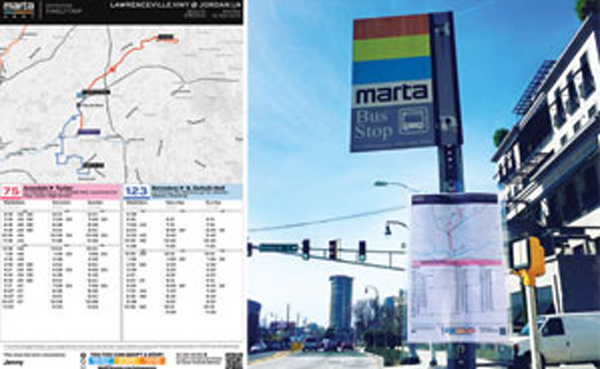Building a Transit Army: How MARTA Army Is Working To Improve Atlanta's Bus Stops
Transit advocacy doesn’t have to move slowly through layers of bureaucracy: in Atlanta, advocates have been mobilizing to improve bus stops in their own neighborhoods.
AT TRANSPORTATIONCAMP DC in January 2017, an event that brought together transportation professionals, technologists and others interested in the intersection of urban transportation and technology, representatives from the grassroots advocacy group MARTA Army shared their organizing model, which has been successful in creating tangible improvements for riders in the Atlanta region.
Getting Started
A self-funded, community-driven advocacy organization and the product of Atlanta-based TransportationCamp South 2014, MARTA Army operates from an activism model centered in acts of “tactical urbanism,” quick, low-cost improvement projects. Simon Berrebi, the group’s executive director, described it as a common enough practice for walking, biking or placemaking projects, but said the group made it their mission to scale up the approach to a large transit system.

MARTA Army members adopted 350 bus stops, printed laminated signs with route and schedule information like that shown at left, and zip-tied them to the stops’ signposts. MARTA Army
As Berrebi described it, the community-driven projects function to enhance the ridership experience. By giving the community a sense of ownership over their transit system, MARTA Army encourages members to participate in improving their transit system.
Operation TimelyTrip, MARTA Army’s original campaign, highlighted the power behind this type of organizing. Of the Atlanta region’s roughly 10,000 bus stops, Berrebi said that hardly any had route information signage on site. MARTA Army members adopted 350 of these stops, printed laminated signs with route and schedule information and zip-tied them to the stops’ signposts.
The operation improved passenger access to accurate bus information and made the system easier to navigate. Due to Operation TimelyTrip’s initial success, MARTA Army is looking to deploy QR codes at stops to provide riders with real-time information on buses. The state of Georgia has even taken notice and granted $3.8 million to further improve bus stops throughout the region.
Another campaign, Operation CleanStop, sought to address the fact that only one in 20 bus stops had a trash can, meaning many suffered from litter issues. The operation ultimately crowdfunded enough money for bins at 80 stops, which the city of Atlanta installed itself.
Growing Success
Despite the model’s success in scaling up the organization, Berrebi did admit that this quick growth is not necessarily sustainable over the long term. Like many advocacy organizations, MARTA Army hasn’t had a problem raising excitement, but there can be disagreements over what to do with that excitement. As a result, Berrebi said MARTA Army would likely need to become a more formal body to effectively address those problems in the future.
Nonetheless, MARTA Army’s experience can help other transit advocacy groups gain footing in their own regions. The group grew from hyperlocal efforts that then moved to influence the entire Atlanta region. It also made a conscious decision not to focus on broader policy, but on what people most care about: their neighborhoods.
Another crucial factor for a successful transit army has been maintaining a broad, regional awareness of efforts and campaigns. MARTA Army needed MARTA’s support to get started, and continues to depend on media coverage both to expand its membership and maintain pressure on the transit agency.
This type of public awareness integrates the role of mass transit into the local identity by portraying transit as a positive and necessary part of every neighborhood’s fabric, convincing the public that they can and should invest in their transportation system. Showing residents that they can actively take part in transit issues — and, by extension, their neighborhood — highlights the benefits of transit and, ideally, increases support for or involvement in expanding it.
As they continue to grow their efforts, MARTA Army is looking to use their resources to help similar efforts get off the ground elsewhere. Its advocacy strategy is not tied to any particular location: any group can adopt its “open source” model and adapt it to their own transit system and city.
Andrew Carpenter, tech reporter, Mobility Lab
This article is adapted with permission from one that appeared on the Mobility Lab website on February 8, 2017.


